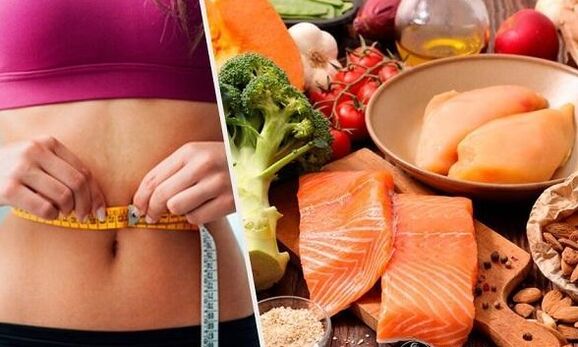The ketogenic (ceto) diet is a very low diet that helps burn fat. It has many advantages for weight loss and health improvement, but also some side effects.

- The advantages of the ceto diet
- That is prohibited in the diet
- How to find out what you are in ketass?
- Side effects of a diet and how to avoid them
The ketogenic diet is similar to other strict carbohydrate diets such as Atkins or LCHF diet. These diets usually end with ketogenic more or less by accident. The main difference between the rigid LCHF and keto diet is that protein is limited in the latter.
With ketosis, the body produces small fuel molecules called "ketones". This is an alternative fuel for the body.
Ketons are produced if you eat very few carbohydrates (which are quickly divided into blood sugar) and a moderate amount of protein (excess protein can also be converted to blood sugar).
How to lose weight in the baby's food?
Ketons are formed in the fat liver. So they are used as fuel throughout the body, including the brain. The brain is an organ that consumes a lot of energy every day and cannot function directly with fat. He can only work in glucose. . . or ketones.
In a ketogenic diet, your whole body changes carbohydrate fuel supply and works almost completely with fat. The insulin level becomes very low and fat burning increases sharply. The body is easy to access your own fat reserves to burn them.
The advantages of the ceto diet
The advantages of a ketogenic diet are similar to any rigorous diet with low car content. However, the effect can be even greater as protein is limited. This diet increases the ketone level and reduces the insulin level.

- Fat burning in the keto diet increases significantly because insulin falls. This creates the ideal conditions under which weight loss can occur without hunger.
- About 20 scientific studies show that, compared to other diets, the diet with little carbohydrate and ceto leads to a more effective weight loss.
- Ketosis leads to sustainable fuel intake (ketones) in the brain. And in a ketogenic diet, you will avoid large fluctuations in blood sugar. This usually leads to an increase in attention and increased concentration.
- Many people specifically use a keto diet to increase mental performance. After a few days (up to a week), the keto adaptation, during which a person may have some difficulties with concentration, headaches, irritability-body and brain will change and can easily work on ketones.
- In a state of ketosis, many people experience more energy.
- The ketogenic diet can also significantly increase its physical resistance by offering constant access to the energy of its fat reserves.
- Carbohydrate body supply (glycogen) is sufficient for a few hours of intensive training, or less. When, as your fat reservations will give enough energy to long and intensive classes.
That is prohibited in the diet
Most importantly, to achieve ketosis, you need to avoid carbohydrate use, ideally reduce consumption below 20 grams. The less carbohydrates, the more effective.
How to find out what you are in ketass?
Ketosis can be measured by testing urine, blood or breathing. But there are clear signs. Symptoms of ketosis: dry mouth, thirst, frequent urination.
Dry mouth and increased thirst. If you drink enough and have enough electrolytes, you may feel your mouth dry. Try to drink a cup of broth or two a day, and drink as much water as possible.
Increased urination is another symptom of ketosis.

The ceto-seque for ketone bodies, the smell of acetone appears in the mouth, the smell can also be "fruit" or resemble the smell of liquid of varnish. Sometimes this smell is felt by sweat, all goes through a short time and after a keto adaptation will pass.
Other less specific but more positive signals include:
Reducing hunger - many people experience a perceptible decrease in hunger. This can be caused by increasing body capacity to be fed by their fat reserves. Many people feel great, eat only once or twice a day, you can do periodic fasting. This saves time and money and also accelerates weight loss.
An increase in energy - after a few days, a fatigue feeling will pass and you will feel an increase in energy and performance.
How to achieve sustainable ketosis
- Limit carbohydrates up to 20 grams per day.
- Squirrel restriction at a moderate level. It is necessary to remain at a level or below 1 gram of protein per day per kg of body weight. This represents about 70 grams of protein per day if you weigh 70 kg.
- There is enough fat to feel full.
- Avoid snacks when not hungry. Unnecessary snacks decrease weight loss and reduce ketosis.
If necessary, you need to add periodic hunger, for example, 16: 8 - 16 hours hunger and 8 hours for food consumption. This is very effective in increasing ketones.
Side effects of a diet and how to avoid them

In the early stage of the transition to kett mode, side effects may occur - this is called keto -gip. Symptoms such as fatigue, nausea, headaches, cramps etc. appear. What needs to be done to prevent or relieve these symptoms:
- Drink water with salt and lemon - You also need to drink a cup of broth daily.
- Gradually reduce carbohydrate consumption - a sharp decrease leads to stronger symptoms
At the early stage of a ketogenic diet, you lose water and therefore electrolytes. This is because carbohydrates delay water and salt in the body; So when you stop eating carbohydrates, your body loses that water.
When carbohydrates were suddenly removed from the diet, the brain needs time before learning to use ketone bodies to get energy instead of sugar. This means that if you markedly reduce carbohydrates, you can get symptoms such as fatigue, nausea and headaches. Reduce carbohydrate consumption for one week or more, the body gets used to burning fat and ketones instead of glucose and the transition will occur easier and without symptoms.






























